Class 9 Exam > Class 9 Notes > Year 9 Science IGCSE (Cambridge) > Revision Notes: Transpiration
Revision Notes: Transpiration | Year 9 Science IGCSE (Cambridge) - Class 9 PDF Download
Transpiration is the process by which plants release water vapor from their aerial parts, such as leaves and stems. This process involves the loss of water in the form of vapor through small openings called stomata.
Demonstration of Transpiration
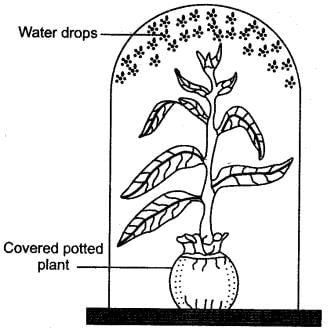
Experiment 1
- When a polythene bag is placed over a plant, drops of water appear on the inner side of the bag.
- In contrast, no such drops are observed in an empty polythene bag.
- This phenomenon occurs because the plant releases water vapor, which saturates the air inside the bag and subsequently condenses on its inner surface.
Experiment 2
- Setup A: Water vapor condenses on the inner wall of the bell jar.
- Setup B: Similar condensation occurs in this bell jar, but the cobalt chloride paper, initially blue, turns pink.
- Setup C: In this setup, no water droplets are found, and the cobalt chloride paper does not change color.
- Observations: Condensation of water vapor occurs on the inner walls of the bell jar in setups A and B.
- The change in color of the cobalt chloride paper in setup B indicates that plants release water vapor during transpiration.
Types of Transpiration
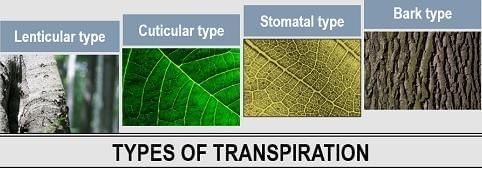
- Stomatal Transpiration: Water vapor escapes through the stomata, which are tiny openings on the leaf surface.
- Cuticular Transpiration: Water transpires directly from the surface of leaves and stems.
- Lenticular Transpiration: Water vapor is released through lenticels, which are small openings on old stems.
- Stoma: A stoma is made up of two guard cells that control its opening and closing. There can be between 1,000 to 10,000 stomata per square centimeter on a leaf.
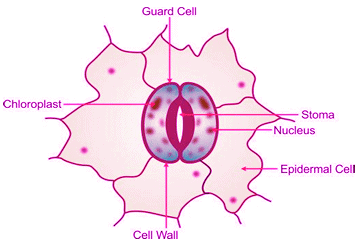
Mechanism of Stomatal Transpiration
- The surfaces of spongy mesophyll cells in a leaf are connected to intercellular spaces.
- Water vapor produced by these cells saturates the air in the intercellular spaces, then diffuses into connected intercellular spaces, reaching the sub-stomatal space before escaping into the atmosphere.
- Turgor pressure in the cells pushes water out into the intercellular space, where it evaporates. The water vapor then diffuses into the sub-stomatal space and out through the stomata.
- Guard cells regulate the opening and closing of stomata.
Experiment
- The cobalt paper placed on the lower side of the leaf turns pink much faster than the one on the upper surface.
- This indicates that more transpiration occurs from the lower surface of the leaf, which is due to a higher number of stomata on the lower surface.
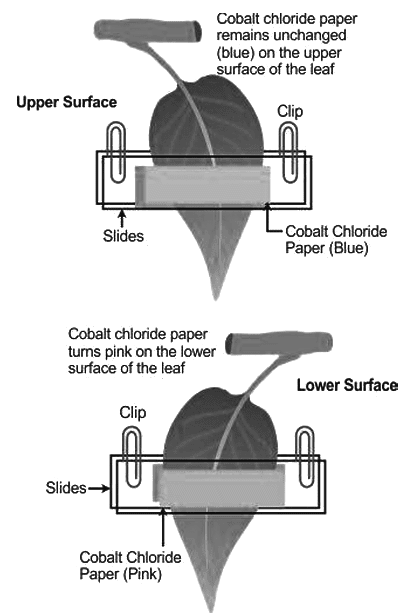
Rate of Transpiration
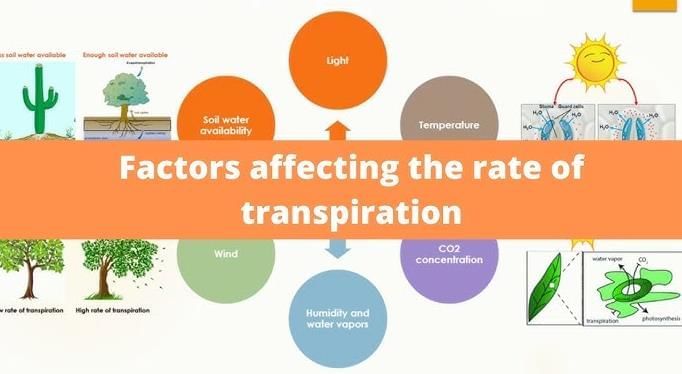
Experiment: Potometer Method
- A potometer is an instrument used to measure the rate at which a plant takes up water, which is nearly equal to the water lost through transpiration.
- In this setup, air bubbles move through the horizontal arm of the potometer.
- The loss of water during transpiration creates a suction force that pulls water from the beaker, causing the air bubbles to move along in the capillary tube.
Factors Affecting the Rate of Transpiration
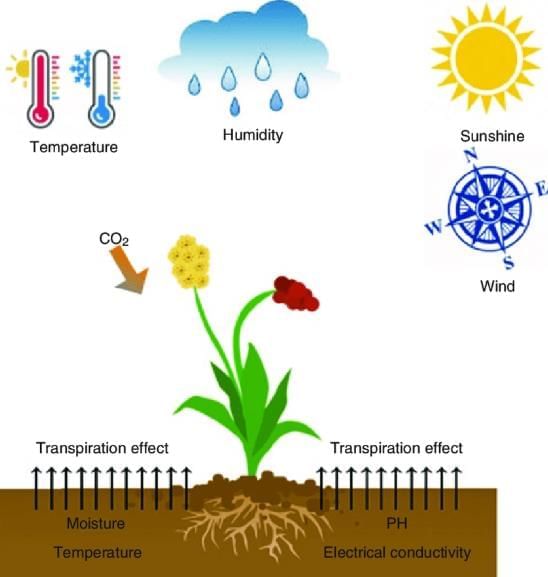
- Intensity of Sunlight: As the intensity of sunlight increases, the rate of transpiration also increases.
- Temperature: An increase in air temperature leads to a higher rate of transpiration.
- Velocity of Wind: Transpiration is enhanced with rapid or strong air movement.
- Humidity: High humidity levels in the air reduce the rate of transpiration.
- Carbon Dioxide: An increase in atmospheric CO2 levels above the normal 0.03% causes stomatal closure, which decreases the rate of transpiration.
- Atmospheric Pressure: A decrease in atmospheric pressure results in an increased rate of transpiration.
Adaptation in Plants to Control Excessive Transpiration
Plants that thrive in dry climates have developed various adaptations to minimize transpiration.
- Leaf Modifications: Leaves may be altered into spines, as seen in cacti, or into needle-like structures, as in pine trees.
- Leaf Folding or Rolling: Leaves may fold or roll up to reduce water loss.
- Stomatal Changes: The number of stomata (tiny openings on leaves) is reduced, and they may be sunken in pits to decrease water loss.
- Cuticle Development: A thick, waxy cuticle develops on the leaves to prevent water loss. Examples of such adapted plants include the banyan tree and evergreen trees.
Significance of Transpiration
- Temperature Regulation: Evaporation of water from leaf surfaces helps to cool them down, reducing leaf temperature.
- Water Uptake: Transpiration creates a negative pressure that draws more water up through the stem, prompting roots to absorb more water from the soil.
- Increased Absorption: A higher rate of transpiration leads to a greater rate of absorption of water and solutes from the soil.
Differences between Transpiration and Evaporation
Transpiration
- Involves the loss of water in the form of water vapour from the aerial parts of the plant.
- This process is relatively slow.
Evaporation
- Refers to the loss of water from the surface of water bodies.
- This process occurs quickly.
Guttation and Bleeding
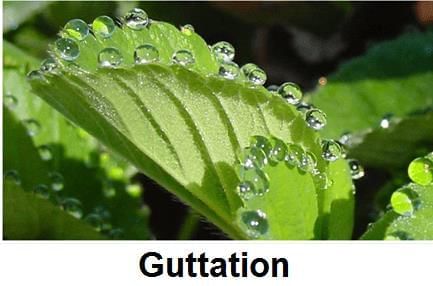
Guttation
- Guttation is the process where water appears as tiny drops along the margins or tips of leaves.
- This phenomenon occurs when there is excessive water loss, and it happens through specialized structures called hydathodes.
Bleeding
- Bleeding refers to the loss of water, specifically cell sap, through a cut stem of a plant.
Differences between Transpiration and Guttation
- In transpiration, water is lost in the form of vapor, while in guttation, water is lost in the form of droplets.
- Water vapor during transpiration is lost through stomata, lenticels, and the cuticle, whereas in guttation, water is lost through hydathodes.
The document Revision Notes: Transpiration | Year 9 Science IGCSE (Cambridge) - Class 9 is a part of the Class 9 Course Year 9 Science IGCSE (Cambridge).
All you need of Class 9 at this link: Class 9
|
2 videos|39 docs|9 tests
|
FAQs on Revision Notes: Transpiration - Year 9 Science IGCSE (Cambridge) - Class 9
| 1. What is transpiration and what are its main types? |  |
Ans.Transpiration is the process through which water evaporates from the aerial parts of plants, primarily through small openings called stomata. The main types of transpiration include stomatal transpiration (through stomata), cuticular transpiration (through the cuticle), and lenticular transpiration (through lenticels).
| 2. How does stomatal transpiration work and what is its mechanism? |  |
Ans.Stomatal transpiration occurs when water vapor exits the leaf through stomata, which are regulated by guard cells. When the guard cells take in potassium ions, they swell and open the stomata, allowing water vapor to escape while facilitating gas exchange for photosynthesis. When the plant experiences water loss, the guard cells lose water and close the stomata to reduce transpiration.
| 3. What factors affect the rate of transpiration in plants? |  |
Ans.The rate of transpiration is influenced by several factors including temperature (higher temperatures increase transpiration), humidity (lower humidity increases transpiration), wind speed (increased wind can enhance transpiration), and light intensity (more light can lead to more stomatal opening). Additionally, soil water availability plays a crucial role as well.
| 4. How do plants adapt to control excessive transpiration? |  |
Ans.Plants have developed various adaptations to minimize excessive transpiration, such as closing their stomata during the hottest parts of the day, developing thicker cuticles, and having leaves with a reduced surface area. Some plants also exhibit CAM (Crassulacean Acid Metabolism) photosynthesis, allowing them to open stomata at night to reduce water loss.
| 5. What is the significance of transpiration in plants? |  |
Ans.Transpiration serves several important functions in plants, including cooling the plant, maintaining nutrient flow by creating a negative pressure within the plant’s xylem, and facilitating the uptake of water and minerals from the soil. It also plays a critical role in regulating plant temperature and maintaining overall plant health.
Related Searches





















